by Carl Valle
This second part of this series reviews not only blood analysis with the new InsideTracker Pro, but how to utilize the training load more effectively with better approaches to quantification. The ABC’s (Activity/Blood/Cardiology) reviewed in part one are on a whole new level with the right data mining and the most practical ways to make change and compliance with team sport.

The last blog introduced the ABC’s of monitoring, a very simple yet effective way to anticipate problems as well as make adjustments on the fly if needed. One of the problems I see with most monitoring programs is that they tend to be centered around one or two fetish performance indicators and have problems with compliance or implementation. Athletes in professional team sports or at Olympic level are not race horses, careful and realistic approaches must be made to get everyone involved and have the athlete’s themselves be engaged.
Data might be the new oil, and it’s common to use Databank verses database since the value of data is growing, along with the amount of it. Mentioned earlier, keeping this clear will keep things simple and fast. Data may tell a story, but it’s up to the coach to interpret the story to ensure that the film is a documentary not a piece of fiction. When I create dashboards for coaches, my experience is that the best want to see the season in a timeline, the most elegant summery of data. Dashboards have value, but they tend to show information we know conveniently. Timelines are better tools and athlete management systems (AMS) that have timeline approaches to their software instead of random pie charts and GPS bar graphs.
Heart rate variability (HRV) and resting heart rate are great daily indicators, but like any data point that summarizes a physiological status, interpretation is always necessary before making decisions on the information. In order to get a system that can allow for better training, the most important question is ‘what are the goals and benchmarks of a successful season?’ Monitoring is only watching, and the best consultants know what to do action wise ahead of time because they have been there as coaches or performance specialists in the past. Accountability is arguably the first area of pro sports, knowing who is responsible for what with evidence is unfortunately the name of the game for job security. Culturally, inability to make a decision after seeing a problem is the equivalent to watching a Greek tragedy, you know the end may not be a good one, but at least you can walk away showing it wasn’t your fault.
Training Load Measurement
With the rise in popularity of monitoring, it seems that everyone is jumping the gun without the most obvious first step, finding out what you are doing with training in a quantitative measurement. Mechanical, biochemical, and neurological strain will create an adaptation or improvement in performance if the load restoration rate isn’t retarded by an inability to recover from it. Not all systems in the body recover as quickly, such as the slow repair rates of tendons (months) compared to the aerobic system (days), so the type of training will dictate what limiting factors will be needing to be watched carefully. Training load measurement is a combination of current or acute output compared to both historical abilities and present fitness levels.
 As you can see, two similar athletes in current abilities may find nearly the same workout completely different in response time based on fitness and genetic make up. I have found that weight training tonnage, heart rate, and GPS distance is convenient for coaches, but the high intensity speed work as well as mechanical strain on the body is the least accessible and analyzed. It’s important that coaches know that management of fatigue generally is on the other side of the spectrum with adaptation of local muscle and system nervous system fatigue with speed work. One of the reasons coaches use crude estimations of work with distance is the lack of calculations of relative effort based on individualized abilities. Similar approaches can be used with all data sets such as strength training and player tracking. To summarize, loads can be quantified by percentage of relative output of the individual rather than an arbitrary approach of physiological estimate or crude volume summary.
As you can see, two similar athletes in current abilities may find nearly the same workout completely different in response time based on fitness and genetic make up. I have found that weight training tonnage, heart rate, and GPS distance is convenient for coaches, but the high intensity speed work as well as mechanical strain on the body is the least accessible and analyzed. It’s important that coaches know that management of fatigue generally is on the other side of the spectrum with adaptation of local muscle and system nervous system fatigue with speed work. One of the reasons coaches use crude estimations of work with distance is the lack of calculations of relative effort based on individualized abilities. Similar approaches can be used with all data sets such as strength training and player tracking. To summarize, loads can be quantified by percentage of relative output of the individual rather than an arbitrary approach of physiological estimate or crude volume summary.
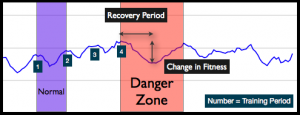
HRV Response – Rolling average as a Lifeline
The autonomic nervous system (ANS) is a hot topic, with coaches wanting to ensure they don’t overtrain athletes. But to simplify fatigue to just single day HRV is not a realistic avenue. Heart rate variability can be used acutely with sound interpretation or used long term to review a program’s ability to fine tune a repeated cycle of training and applied sport science to a competitive season. Since a rolling average is included in the ithlete system, the line plot to me is perhaps the most useful summary to see trends and the results of interventions. My favorite example is the athlete here, a soccer athlete whose rolling average during preseason conditioning shows almost a textbook display of alternating rest and stress to increase conditioning capacity from progressive overload and well-timed pedagogical recovery. Then, after the fourth peak, the athlete nearly crashes and didn’t respond to planned rest because his blood markers of aerobic function were impaired. His testosterone and vitamin D improved from training in the sunny outdoors in Florida and by getting better sleep and training, but his HRV recovery rate was so poor that without blood analysis, we could have rested him to the point he would be rotting his fitness levels.
The athlete avoided a performance crash or possible injury from fatigue because iron supplementation was prescribed when the athlete was unable to recover at normal rates. The recovery period is when the athlete is able to reach the most current level of performance or greater, and when they are not able to blood analysis is sometimes necessary. Using a simple line plot with HRV rolling average and seeing the weekly drops (change in vitality or fitness) is a great way to see if the prescribed load is matching the recovery from it. From the graphic, the preseason was a steady and progressive improvement and nearly all biomarkers improved with blood testing as the athlete ate and rested better, but one simple nutrient left the athlete susceptible to a crash. The study from Peter Krustrup and colleagues outlines an integrated model of blood testing, physical performance testing, and body composition testing over a season. I have used this model suggested by InsideTracker‘s Pro system and so far the results have meant no crashes or problems with my athletes from overtraining.
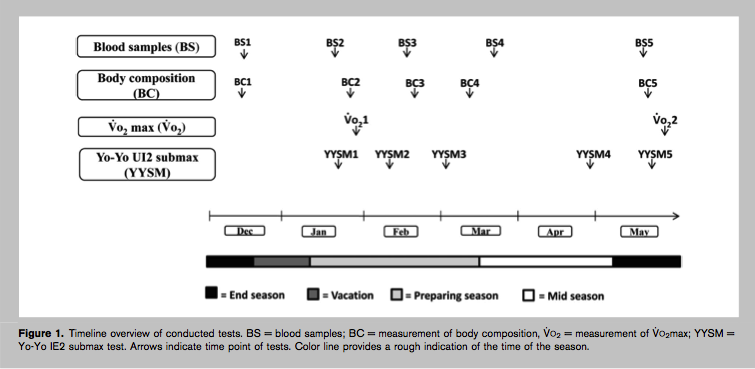 The blood test was done a few weeks earlier as the earlier test showed a small decline in ferritin even after the athlete’s photo food log indicated an effort to make dietary change. When the recovery was impaired, a blood test was scheduled the next day with a nearby lab, one of 1500 in the United States, and the results were quickly received. The athlete was compliant with nutrition but food chemistry is not as simple as eating a good well balance diet as they say. On paper his consumption was adequate to make an improvement, but food totals don’t equate for absorption because the body’s digestive system is not an excel column. Analyzing further, a coffee drink costumed at the wrong time or an increase of fortified foods can dramatically impact and disrupt the absorption of iron. Very few athletes, save the type A endurance athlete, will keep such as specific food log that they will be able to get accurate assessment of iron absorption. Testing is far more objective to help athletes with direct status of both nutrients and other biomarkers important to health and performance.
The blood test was done a few weeks earlier as the earlier test showed a small decline in ferritin even after the athlete’s photo food log indicated an effort to make dietary change. When the recovery was impaired, a blood test was scheduled the next day with a nearby lab, one of 1500 in the United States, and the results were quickly received. The athlete was compliant with nutrition but food chemistry is not as simple as eating a good well balance diet as they say. On paper his consumption was adequate to make an improvement, but food totals don’t equate for absorption because the body’s digestive system is not an excel column. Analyzing further, a coffee drink costumed at the wrong time or an increase of fortified foods can dramatically impact and disrupt the absorption of iron. Very few athletes, save the type A endurance athlete, will keep such as specific food log that they will be able to get accurate assessment of iron absorption. Testing is far more objective to help athletes with direct status of both nutrients and other biomarkers important to health and performance.
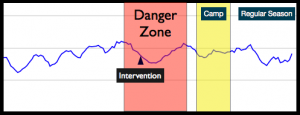
After the intervention was administered (iron supplements), a few weeks of conservative training with the iron supplementation appeared to help with the rolling HRV and another test confirmed the ferritin status along with other measures. One fear was the level of Hemoglobin, a biomarker that is associated with aerobic output, would be extremely low. After the re-test, the hemoglobin results showed it was sufficient and later a Yo-Yo IR2 test confirmed he was in excellent aerobic shape for the start of the season.
Biomarker Interaction
HRV is general warning light but with at least quarterly blood testing a medical specialist or performance coach can see why HRV may be crashing or chronically low for the athlete. I have used the Sports Data Hub model of width, speed, and depth to monitor athletes by getting data quickly, with an array of biomarkers, and a high level of detail to drill down and get answers. Here is a simple approach to implementing the data concepts by Kevin Goodfellow’s presentation from the MIT Sloan Sports Analytics Conference when dealing with blood testing.
Width
To implement width, coaches will need a wide panel to cover a spectrum of the most common needs to monitor and retest in a rhythm that makes sense and is practical. A great way to cover the bases to provide testing 4-6 times a year with 20-30 biomarkers to a team instead of testing one or two biomarkers every week or doing a mega panel once or twice a year. For a trend to be seen, you need at least three repeated data points, and some biomarkers are more acute than others so a moderation approach is best. A careful balance of the most useful and actionable biomarkers help sports medicine screen for potential problems and coaches monitor training and adaptation.
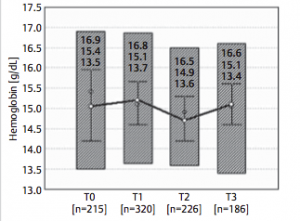
Speed
Blood tests can come back in a few days and give immediate results of vitamin status, mineral deficiencies, and other indicators such as inflammation and hormone responses from training, but the rate of processing is as important as the intervention system already in place. Time after time it takes weeks and weeks for something as simple as Vitamin D levels to be addressed because of red tape. A nutritionist on vacation, a supplement vendor behind because of backorders, an athlete not filling out a nutrition questionnaire, and countless other real world problems plague getting interventions done. Anticipating the possible problems in advance and coming up with sensible solutions makes the entire process faster. Software with effective algorithms using validated research can accelerate the interventions and see relationships that are more preventive than reactive. The new frontier will be algorithm development to help support athletes to find the most effective approaches to performance and player health.
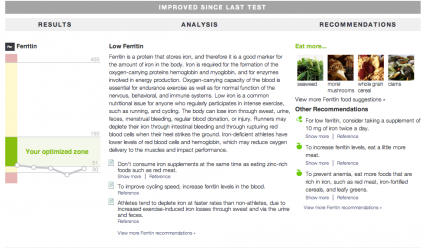
Depth
The degree of detail a performance coach can address in training is based on how much experience one has working with athletes and seeing the same or similar problems surface. Data mining is not about searching for information further away from the source, but finding deeper connections to what one has already. When a coach is exposed to a challenge and has been there before, the familiarity allows him or her to take a step further than before and do more with the next athlete as they are veterans to the problem. Every trip through common challenges such as improving nutrition or recovery is no longer a foreign problem, it’s a path taken before. A good example I have is Iron status and what should be done to ensure speed and power athletes don’t get crippled from one chemical element being missing from a diet or the inability to absorb it from the complex interactions of other compounds that impair its uptake. The surprising complexity of ensuring athletes have the optimal ferritin levels in their body is far more demanding than at first glance. An athlete can be trying to improve other vitamin and mineral update or trying to get enough macronutrients with healthy food options and still have absorption issues. Also, an increase in training will reduce iron levels, so an athlete starting the season in the hole could find themselves crashing midway if they are not careful.
Compliance and Culture Change
While the ABC’s are important, it can be also argued that the three “C”s are just as important because sports science theory becomes useful when it’s applied. Compliance and culture change is always brought up with team coaches as one can’t really choose who you work with in team settings, and sometimes the feelings are mutual with the athletes! I have found the most difficult of divas and the most rebellious alpha males tend to respond to explanation and honesty. Too many yes men exist in pro sports, and athletes like hearing someone that may disagree with them and share a down to earth educational exchange of why something will help them. Yes it’s a selling process and requires a little guile, but it’s amazing what athletes will do on their own if they believe in something and sometimes athletes will do something for a private consultant because of a relationship of trust and time. Team coaches can build that relationship by how they treat the data they collect and how they report it. The process is not always going to be convenient, but many times data can be rewarding to the athlete because most believe in numbers, just not the numbers coaches and medical professionals love to see. Here are five simple ways to improve compliance with the combination of training load, blood analysis, and HRV.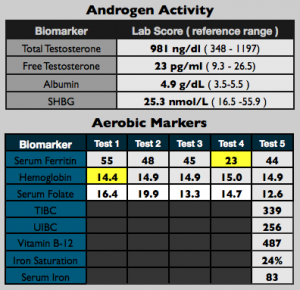
Use the ithlete Team App SMS Feature
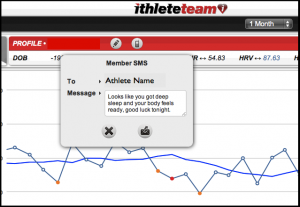
Immediate feedback and dialogue by a simple text message from the ithlete Team App shows the athlete you are using the data they collected. So many times data is taken like a numerical kidnapping that athletes don’t feel the value unless they get feedback from it directly every day. Having the data visible in a private report sent by email or on a flat screen creates a talking point. Athletes need to know you use the data to construct training programs or make decisions for interventions.
Info Graphics
Athletes don’t care about most biomarkers, but a few will perk them up to attention such as Testosterone. Talking about sleep may get old, but when they see how performance is endangered by sleep loss it’s enough to do damage control. Many factors and other biomarkers can contribute to total testosterone levels, and while the hormone is not all telling, it does create a good dialogue about how lifestyle is so important.
Athlete Dashboards
The most bizarre idea is that dashboards for monitoring are some sort of tool for coaches only is strange when athletes need to be reminded more than the coaches. The great thing about ithlete is that both the athlete and coach can share the data and allow athletes to collect it by themselves if they are engaged. Having the athlete see the data is part of the repetitions needed to make a change, something that’s not going to happen through a quick meeting. Athletes seeing a chart or graph allows for immediate interoperation and objective feedback that removes the debate in opinions of what is happening.
Catered Meals or Menu Help
Athletes will eat better if the food tastes better. Sometimes a few simple adjustments to conventional comfort foods can be transformed with some creative twists provided that you ask what the athlete likes to have and work from there.
Many athletes don’t grow up with pallets that are sophisticated like professional chefs, and slow migration to new things will be possible with catered meals based on blood testing. I have 80 catering companies and nearly 400 menus from private consultants
Metrics and Benchmarks
Random goals will never inspire, but listening to the athletes and cooperating to find some sensible goals always seems to be the best solution to creating change, provided they can see results in a reasonable amount of time without huge sacrifice. The little things add up to the spectacular, so a small habit goal will eventually create a nice change to something simple like doing the right off-season conditioning to pass a yo-yo test. Breaking down goals into small metrics via objective monitoring such as HRV and blood analysis is very effective.
Case Study: Lesson in Attention to Detail
At the Boston Sports Medicine and Performance Group summer conference the idea of monitoring being a focal point was interesting, but the definition of watching versus appraising came up in a later talk about European soccer and the lack of training. Dr. Marco Cardinale brilliantly showed the need to rethink periodization, the planning of training, when no time to train is given with modern fixtures or schedules. In the EPL many athletes use their own medical and performance coaches since their confidence in the competence of their team coaches is never established because of the change in staff after managers get sacked, or fire their staff when they are losing. With some teams using their weight room for equipment catalog photo shoots, this actually has created a wide open option for athlete to train in the later afternoon with their private coaches that are providing a service in both monitoring and training. Using some custom hardware and simple sport science principles, a private coach can create a simple template of workouts that can be repeated based on the responses of the body globally, and see the changes in local fatigue with Tensiomyography (TMG). Using all of the variables a coach can decide if one does grass running instead of a pool workout, or decide to do a long circuit versus a quick neuromuscular intensive option. While the workouts are not earth shattering in design, the genius is the specific volumes and selective placement. Unfortunately many teams are not leveraging the innovations because high end performance consultants are very private and cater to gaps in coverage of support, something they don’t want to close by sharing their knowledge.
In closing, I showed through examples how simple training data, Heart Rate Variability with ithlete and blood analysis with InsideTracker, can be a comprehensive solution to coaches and medical professionals looking to have the power of current technologies and sport science without the drawbacks of cumbersome programs that look good on YouTube demos or other marketing tools but fail to deliver when it counts in the trenches. In the next and final part I will go over billing (private facility) and budgeting (team organizations) with collecting the best data and how to implement interventions that are market friendly and cost effective.
